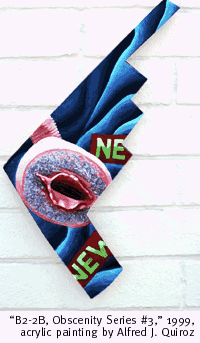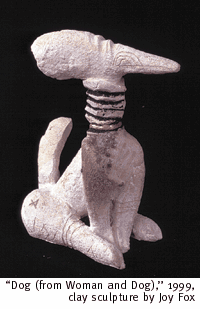

|

Davis Dominguez Gallery Stages Its Annual Show Of Compact Creations.
By Margaret Regan
IF YOU HAD to pick one influence that shapes Southern Arizona
art more than any other, it would probably be the desert land.
Photographers here prize its intense light, painters its broad
expanses and horizontal planes, its layerings of earth, mountain
and sky. Non-traditionalists and abstractionists might say nay,
but even for them the openness of the country and its free-wheeling
new culture suggest the long view.
 So it's no surprise to find a goodly sample of landscape painting,
and even, comically, one landscape sculpture, in this year's edition
of the Small Works Invitational at Davis Dominguez Gallery.
Each summer the gallery stages a command performance of assorted
local artists--this year there are 45--inviting them to submit
paintings no larger than one foot square, pedestal sculptures
no more than 18 inches high. The idea is to give a snapshot of
Southern Arizona's variety of artistic styles, each distilled
into its tiny essence.
So it's no surprise to find a goodly sample of landscape painting,
and even, comically, one landscape sculpture, in this year's edition
of the Small Works Invitational at Davis Dominguez Gallery.
Each summer the gallery stages a command performance of assorted
local artists--this year there are 45--inviting them to submit
paintings no larger than one foot square, pedestal sculptures
no more than 18 inches high. The idea is to give a snapshot of
Southern Arizona's variety of artistic styles, each distilled
into its tiny essence.
One of the best landscape entries is from Debra Salopek of Elgin,
who has made a luminous little painting of the open grasslands
where she lives. Done up in Old Master oils with heavy glazing,
"Two Oaks" has a picture plane that's simple, in the
same way that the land is. A band of blue-green sky lines the
top, a broader expanse of gold grass lies below. The two trees
of the title stand sentinel on the horizon. Salopek's beguiling
painting style yields no harsh lines or sharp divisions, though,
only a gentle, organic blurring that mimics the real earth. This
wonderfully dense little painting compresses both emotional power
and visual impact into a panel no more than 12-by-12 inches.
 There are plenty of other landscapes, but the only honest-to-God
desert picture is Philip Melton's disappointing "I Knew It
Would Happen," a dry and stubby acrylic on canvas of a woman
striding among the cacti. More happily, sculptor Judith Stewart
does a humorous desert sculpture, a bronze made tactile by the
marks of her own fingers. "Traveling Venus Sees Mickey Mouse-eared
Cactus" features a headless, armless Venus de Milo touring
among the corrugated mountains and prickly pears. Her valise is
set aside on the desert floor, her camera at the ready on a truncated
thigh.
There are plenty of other landscapes, but the only honest-to-God
desert picture is Philip Melton's disappointing "I Knew It
Would Happen," a dry and stubby acrylic on canvas of a woman
striding among the cacti. More happily, sculptor Judith Stewart
does a humorous desert sculpture, a bronze made tactile by the
marks of her own fingers. "Traveling Venus Sees Mickey Mouse-eared
Cactus" features a headless, armless Venus de Milo touring
among the corrugated mountains and prickly pears. Her valise is
set aside on the desert floor, her camera at the ready on a truncated
thigh.
Bruce McGrew has contributed one of his trademark liquid watercolors,
"Silver and Gold," a tiny vertical painting that summarizes
the sky, mountains and earth of the region in a deft shorthand.
The painter Charlotte Bender fragments the mountain West in "Maxwell's
Dream," framing a peak and a moon with tree branches. Sprinkled
with silver and gold paint, her kaleidoscopic composition verges
on the abstract.
Others undertaking the landscape have been inspired more by the
idea of open country rather than by Arizona's literal features.
Robert Cocke, whose residence north of Phoenix makes him an exception
to the show's Southern Arizona rule, has painted an imaginary
land in acrylic on wood. His "Crossing" has the big
open space of the West but its horizon boasts a storybook city,
along the lines of Oz. Likewise, Bailey Doogan, a UA prof usually
given to serious renderings of female flesh, has contributed "Little
Landscapes," two fantasy oils on paper of a fairy-tale land
of pink cliffs and a yellow-blue sea.
Then there are the works influenced by local flora and fauna.
Sculptor Joy Fox's typically makes mythical figures out of the
region's clay, their beige and blackened bodies incised with petroglyph-style
markings. "Woman and Dog" is characteristic: a dog stands
guard over a dog-headed woman. And painter Jim Waid, who's been
doing colorful riffs on desert imagery for years, has painted
"Mothra," an acrylic on canvas that brings to life a
moth? a butterfly? in radiant royal, yellow and red.
 Davis Dominguez specializes in paintings with surface interest.
Landscape painters who push a bit beyond realism, such as McGrew
and James Cook (here represented by an ocean study), are some
of their most successful artists. So this show does tend toward
the traditional in media, but proprietors Candice Davis and Mike
Dominguez have made some efforts to acknowledge new kinds of work.
Davis Dominguez specializes in paintings with surface interest.
Landscape painters who push a bit beyond realism, such as McGrew
and James Cook (here represented by an ocean study), are some
of their most successful artists. So this show does tend toward
the traditional in media, but proprietors Candice Davis and Mike
Dominguez have made some efforts to acknowledge new kinds of work.
Barbara Jo McLaughlin's jocular "Jock" is a soft sculpture
with virile pubic bristles jutting out of beige cloth, a leather
baseball glove-looking thing lashed on with suede string. It would
not be at all out of place in the Tucson Museum of Art's contemporary
art biennial. Leslie Ann Epperson has made one of her deft photographic
collages, "By the Rocket's Red Glare," layering old-timey
photos of little girls in a cityscape colored Fourth of July red,
white, blue and teal. Similarly, Josh Goldberg's "Nachman's
Night-Ensouled Chair" is a dark, mixed-media collage dimly
picturing a nightmarish chair and flying papers.
Leave it to UA prof Alfred J. Quiroz, a gallery regular and king
of the outrageous, to bring together unconventional media and
regionalism. Inspired perhaps by the city's undeniable military
culture--and vast graveyards of bomber planes at Davis-Monthan--Quiroz
assaults the senses with "B2-2B, Obscenity Series 3."
It's a cross between painting and sculpture, an acrylic painting
cut out in the shape of the extravagantly costly B2 bomber. In
one lethal package, painted with advertising slogans and genitalia,
Quiroz lays waste to American consumerism, commercialized sexuality
and our nation's killing machines.
The 7th Annual All-Tucson Small Works Invitational continues
through July 31 at Davis Dominguez Gallery, 154 E. Sixth St. Gallery
hours are 10 a.m. to 5 p.m. Tuesday through Friday, 10 a.m. to
4 p.m. Saturday. For more information call 629-9759.

|
 |



